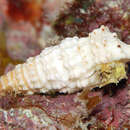Comprehensive Description
provided by Smithsonian Contributions to Zoology
Cerithium munitum Sowerby, 1855
Cerithium pyramidatum Hambron and Jacquinot, 1852, pl. 23: figs. 20, 21 [holotype MNHNP, no number, 325 mm × 12.8 mm; type locality: Hogoleu; not Cerithium pyramidatum Deshayes, 1834]; 1854:100–101.—Tryon, 1887:129.
Cerithium munitum Sowerby, 1855:858–859, pl. 180: fig. 93 [type not found, type locality: Masbate, Philippines; neotype herein designated: AMS C117184, Broadhurst Reef, E of Townsville, Queensland, Australia, 40.3 mm × 16.3 mm]; 1865, pl. 10: fig. 69 [reference to Philippi and citation of Mediterranean in error].—Tryon, 1887:129, pl. 23: figs. 82–84.—Kobelt, 1898:211–212, pl. 37: figs. 10, 11.—Abbott and Dance, 1982:64.
Cerithium proditum Bayle, 1880:249 [new name for Cerithium pyramidatum Hombron and Jacquinot, 1852; not Cerithium proditum Bayle, 1880, pl. 246, new name for Cerithium fusiforme Sowerby, 1855].
Cerithium audouini [sic] Bayle, 1880:354 [new name for Cerithium pyramidatum Hombron and Jacquinot, 1852].
Cerithium sucaradjanum Martin, 1899:197–198, pl. 31: fig. 455 [holotype: RMGM St-10256, 33.2 mm × 11.8 mm; type locality: Selatjau, Tji Longan, Sukaradja District, Java; Pliocene].
Cerithium talahabense Martin, 1899:201–202, pl. 31: fig. 462 [holotype: RMGM, no number, 20 mm × 9 mm; type locality: St-10374, Tji Talahab, Djampangtengah, Java; Pliocene].
Cerithium dautzenbergi Vignal, 1902:303–304, pl. 8: figs. 11, 12 [holotype MNHNP, no number, 35.9 mm; type locality: Île des Pins, New Caledonia].
Cerithium Boettgeri [sic] Icke and Martin, 1907:241–242, pl. 16: fig. 26a,b [holotype: RMGM, no number, type locality: Dahana, Nias, Indonesia; Upper Miocene; not Cerithium boettgeri Von Koenen, 1882].
Cerithium ickei Vignal, 1908:136 [new name for Cerithium boettgeri Icke and Martin, 1907; not Cerithium ickei Martin, 1914].—Altena, 1938:208.
Cerithium vandervlerki van der Vlerk, 1931:288 [new name for Cerithium boettgeri, Icke and Martin, 1907].
Cerithium (Thericium) ickei Vignal.—Wissema, 1947:64–65, pl. 3: figs. 70–72.
Cerithium (Cerithium) aff. C. columna Sowerby.—Ladd, 1979:39. pl. 10: fig. 2.
DESCRIPTION.— Shell (Figures 82, 83): Shell elongate, turreted, with wide body whorl, comprising 14 or 15 inflated, angulate whorls, and reaching 39.8 mm length and 16.1 mm width. Protoconch unknown. Early teleoconch whorls with broad, sloping, subsutural ramp and sculptured with axial ribs and three spiral cords; first spiral cord on subsutural ramp, and remaining two on whorl periphery. Adult teleoconch whorls with broad, sloping, subsutural ramp, and sculptured with numerous fine spiral striae, spiral row of subsutural plicae, axial ribs, and with one keel-like, nodular spiral cords at whorl periphery. Anti- and penultimate whorls with 11–19 weak to strong, sinuous axial ribs joining nodes to subsutural plicae. Suture wavy, distinct. Body whorl large, very wide, with strongly excavated base, tightly constricted siphonal canal, and sculptured with 2 or 3 spiral, weakly beaded threads and two, keel-like, spiny peripheral cords. Beads and spines usually joined by weak axial ribs. Aperture ovate, about 3.5 times the shell length. Columella moderately concave with strong callus and lip. Anterior siphonal canal well developed, of moderate length, and reflected dorsally to left of shell axis. Anal canal well developed, bordered by parietal columellar tooth extending into aperture. Outer lip convexly flared and crenulated with interior, spiral incised lines. Shell color white to light tan, occasionally brown, sometimes with thick spiral bands of white and tan or with very thin tan spiral threads; nodes and aperture white. Measurements (Table 28). Periostracum thin, tan. Operculum (Fig. 83J) corneous, oval, thin, tan, paucispiral with nucleus close to edge, and covered with fine, microscopic pustules (Figure 84A).
Radula (Figure 84B–D): Type-1 radular ribbon (Figure 3A) short, about one-eleventh the shell length. Rachidian tooth (Figure 84C,D) triangular with rounded edges and concave front, with pair of posterior ridges and short, median triangular extension on cutting edge with large, spade-shaped main cusp flanked by 2 or 3 very small, blunt denticles. Lateral tooth (Figure 84C–I) with long posterior, lateral extension and narrow central buttress bearing small median bump; cutting edge with broad, spade-shaped main cusp, one inner flanking pointed denticle, and 2 or 3 outer flanking, pointed denticles. Marginal teeth (Figure 84B,D) with long narrow shafts, curved, elongate tips and long finger-like apices. Inner marginal tooth with 2 or 3 inner flanking denticles, and 1 or 2 outer flanking denticles. Outer marginal teeth same, but lacking outer flanking denticles.
Anatomy: Animal tan with white blotches and small black dots. Snout with thin dark stripes. Cephalic tentacles thin, elongate, with large peduncles, each with small black eye bordered with yellow. Mande edge with long, equally spaced papillae, each with transparent edges and opaque, white centers. Underside of mantle at inhalant siphon with short, muscular ridge.
Osphradium black. Ctenidium long, whitish, turning brown anteriorly, comprised of narrow, triangular filaments. Large hypobranchial gland with darkly pigmented, glandular anterior extending from exhalant siphonal edge to ctenidial tip. Wide rectum containing rod-shaped fecal pellets comprised of fine sand grains and detrital particles.
Female pallial oviduct with very short sperm gutter in anterior edge of medial lamina. Male pallial gonoduct with prostate at posterior end.
Buccal mass with pair of jaws comprising many, very small, rectangular, scale-like plates. Pair of tiny salivary glands passing through nerve ring as thin tubes. Esophageal gland present. Stomach large, with style-sac, crystalline style, and gastric shield.
SYNONYMIC
- bibliographic citation
- Houbrick, Richard S. 1992. "Monograph of the genus Cerithium Bruguiere in the Indo-Pacific (Cerithiidae: Prosobranchia)." Smithsonian Contributions to Zoology. 1-211. https://doi.org/10.5479/si.00810282.510

